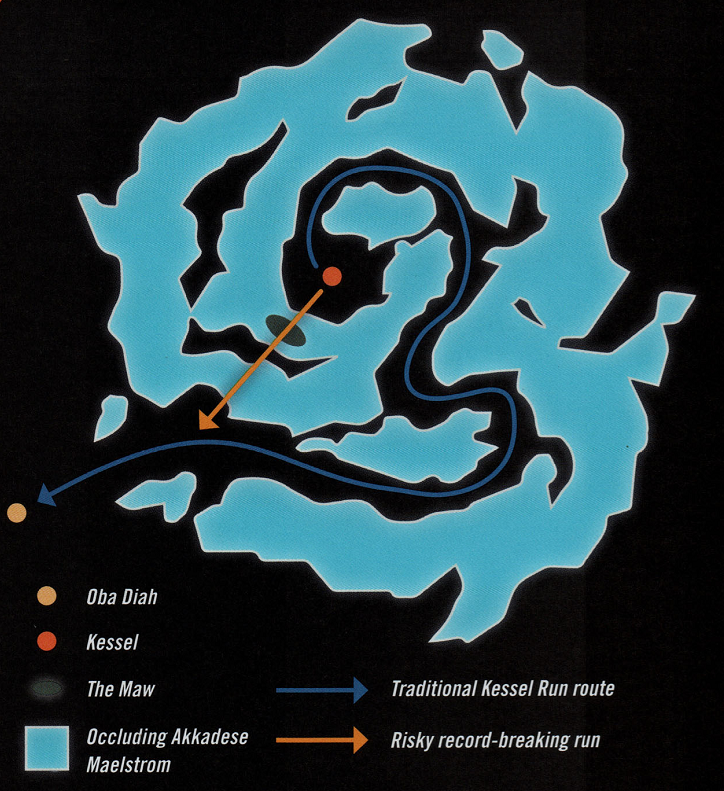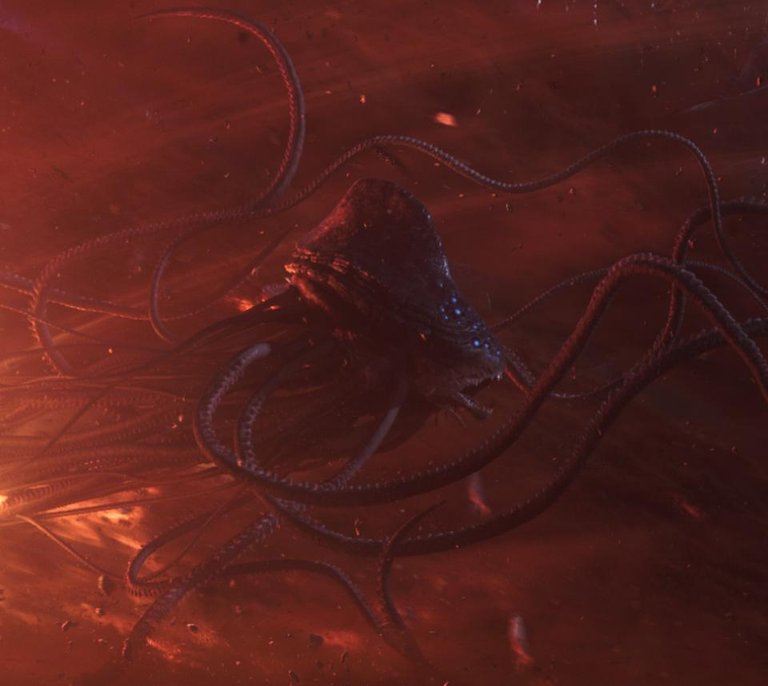Solo: A Star Wars Story exists entirely to correct a single scientific inaccuracy from A New Hope. And you know what? I'm entirely okay with that. It's a fast paced, fun, and lighthearted little movie, and well worth the time to see. (It's also the first Star Wars movie with no real references to the force.) It also gives me the opportunity to do another Movie Science post, which makes me happy indeed. Fair warning, lots of spoilers ahead!
First off- yes, Solo adequately solves the Kessel Run problem. In the original Star Wars film, Han Solo boasts that he did the Kessel Run in only 12 parsecs- which was problematic, because a parsec isn't a unit of time, but a unit of distance. Solo solves this by putting the planet Kessel in the midst of a massive interstellar cloud filled with black holes and debris, the Akkadese Maelstrom. The only way through is a winding, 20 parsec long route through the cloud. Han Solo pilots the Millennium Falcon straight through the worst of the mess, cutting the route down to 12 parsecs. (1 parsec is equal to 3.26 lightyears, by the way, so that's an extremely shortened route.
However, they don't fly the route at lightspeed, so they certainly didn't travel 39.12 lightyears, but that would have made for much less interesting action scenes. The chase through the Maelstrom was nothing if not thrilling. It does, however, fit Star Wars canon- large bodies of mass cause interference in hyperspace, meaning that it's dangerous to take new, unexplored hyperspace routes- hence all the references to hyperspace lanes in Star Wars. So we either have to assume that parsecs are smaller or that was just a science error in the movie for the purposes of making it more thrilling.
A map of the Akkadese Maelstrom, showing the normal routes and Han Solo's riskier route. [Image source]
Next, though, we've got to talk about the Akkadese Maelstrom itself. It's a massive cloud of ionized gas, water vapor, and "carbon-bergs" the size of small planets. It makes for awesome action scenes, but is it scientifically plausible? There's a few parts to that. First off, the absurd density of the cloud- it's as thick or thicker than clouds on Earth, an absurd level of density for outer space. Immediately next to the Maw, the sullen black hole inside the Maelstrom, that level of density makes a little sense, but for the rest of it? Not really, especially considering the immense size of the cloud. A cloud that dense and large should have collapsed into stars and planets by now.
Assuming the map of the Maelstrom I pulled of the Star Wars Wiki is to scale, we can safely assume that it's at least 24 parsecs across on the axis of the Millennium Falcon's record breaking Kessel Run. That's 78.24 lightyears. Not out of reason for the size of a nebula- some can reach hundreds of lightyears in diameter. None of the really big ones even close to approaching the density of the Akkadese Maelstrom. A nebular section the size of Earth would contain mass equivalent to a few kilograms- not very much at all. Planetary nebulas have considerably higher density, especially early in their lifespans, but still not at the level of the Maelstrom. So the Maelstrom gets a pass on size, but not on density.
The Pillars of Creation, part of the Eagle Nebula, an example of a nebula from the real world. [Image source]
What about the composition of the Maelstrom? It contains "interstellar gas, carbon-bergs, ice chunks, and other debris", according to the Star Wars wiki. We don't get any percentages, unfortunately. None of the contents of the nebula are overly unusual, save for the carbon-bergs, but the percentages are key- your normal nebula has a composition that basically mirrors the universe at large. If I had to guess, I'd say the nebula has a disproportionate level of carbon, given the carbon bergs- they should have more silicon and such in them. I'm assuming the carbon bergs are probably the result of the Maelstrom beginning to collapse onto itself due to its gravity, and as such they should be somewhat representative of the composition of the cloud.
So the Maelstrom is unrealistic. What about the coaxium, the unrefined hyperspace fuel from the movie? Well, more math minded individuals than me have calculated that the energy contained in coaxium is fairly similar to enriched uranium. Its tendency to implode after exploding, though? That's a weird property not shared by any other material, to my knowledge.
The Summa-Verminoth. [Image source]
We've got one other big science question in regards to Solo: the plausibility of the giant tentacle monster living in the Maelstrom, the Summa-verminoth. The answer? A flat no. Nope. Not even a little. While space-faring lifeforms are possible, they're most likely to be photovoric microorganisms, or if they're macro-organisms, basically living solar panels with ridiculous amounts of surface area to every unit of volume. Other morphologies are possible, but without an atmosphere to provide constant chemical fuel like we get from Earth's atmosphere's oxygen, they're not going to have much energy for doing stuff in space- certainly not firing lightning bolts or flying around without any reaction mass. Still, though, it looks really, really cool.
Bibliography:
- http://www.astronomy.ohio-state.edu/~ryden/ast162_3/notes11.html
- https://theconversation.com/why-blasters-miss-their-mark-and-other-science-stunners-in-solo-a-star-wars-story-96631
- http://phillips.seti.org/kids/nebulae.html
- https://en.wikipedia.org/wiki/Parsec
- https://en.wikipedia.org/wiki/Nebula
- https://en.wikipedia.org/wiki/Solo:_A_Star_Wars_Story
- http://starwars.wikia.com/wiki/Akkadese_Maelstrom
- http://starwars.wikia.com/wiki/Summa-verminoth
- https://www.forbes.com/sites/jvchamary/2018/05/30/solo-star-wars-story-kessel-run-12-parsecs/#281ec5243785
- http://starwars.wikia.com/wiki/Coaxium






Great post and I agree with the science.
But question: If The Summa-Verminoth could not live in space, how did the giant octopus live in space in the recent Guardians of the Galaxy?

Is this Hollywood pushing science too far source?
Speaking of firing bolts, I thought it would be cool if just one movie (besides Gravity which is "non-fiction space") shows someone firing something, a gun or lazer, and then having them fly off in the opposite direction (keeping real forces, not "the force" real). That would be perhaps a cool future post (real forces in space). Great post have a great night!
The giant octopus monster from Guardians of the Galaxy Volume 2 was actually from another dimension, not space!
Out of this world! That is a very very good point!
Now I may want to see the movie. Thanks ^^
I know, this was not the goal of your post, but well... The unexpected always happens.
It is a really fun movie!
I believe it. And I will have to see it with the big one at some point :)
So much fun.
Thank you for taking the time to put these posts together.
What an interesting way to use your scientific training.
Thanks, I'm glad you enjoyed it! There will be more soon, I promise!
Hi @mountainwashere!
Your post was upvoted by utopian.io in cooperation with steemstem - supporting knowledge, innovation and technological advancement on the Steem Blockchain.
Contribute to Open Source with utopian.io
Learn how to contribute on our website and join the new open source economy.
Want to chat? Join the Utopian Community on Discord https://discord.gg/h52nFrV
This post has been voted on by the steemstem curation team and voting trail.
There is more to SteemSTEM than just writing posts, check here for some more tips on being a community member. You can also join our discord here to get to know the rest of the community!
Ah but maybe the monster taps into the Dark Energy! 😆
I need your support sir
https://steemit.com/mgsc/@bbkiwine/why-i-ve-chosen-steemit-platform
Spam.